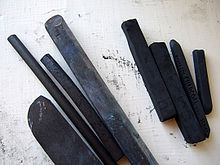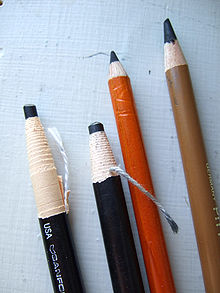Metallurgical fuel
Charcoal burns at intense temperatures, up to 2700 degrees Celsius. By comparison the melting point of iron is approximately 1200 to 1550 degrees Celsius. Due to its porosity it is sensitive to the flow of air and the heat generated can be moderated by controlling the air flow to the fire. For this reason charcoal is an ideal fuel for a forge and is still widely used by blacksmiths. Charcoal is also an excellent reducing fuel for the production of iron and has been used that way since Roman times. In the 16th century England had to pass laws to prevent the country from becoming completely denuded of trees due to production of iron. In the 19th century charcoal was largely replaced by coke, baked coal, in steel making due to cost. Charcoal is far superior fuel to coke, however, because it burns hotter and has no sulfur. Until World War II charcoal was still being used in Sweden to make ultra high-quality steel.Cooking fuel
Prior to the industrial revolution charcoal was occasionally used as a cooking fuel. Modern "charcoal briquettes", widely used for outdoor grilling and barbecues in backyards and on camping trips, imitate this use, but are not actually charcoal. They are usually compacted mixtures of coal or coke and various binders.Industrial fuel
Historically, charcoal was used in great quantities for smelting iron in bloomeries and later blast furnaces and finery forges. This use was replaced by coke during the Industrial Revolution. For this purpose, charcoal in England was measured in dozens (or loads) consisting of 12 sacks or shems or seams, each of 8 bushels.[citation needed]Automotive fuel
In times of scarce petroleum, automobiles and even buses have been converted to burn wood gas (a gas mixture consisting primarily of diluting atmospheric nitrogen, but also containing combustible gasses, mostly carbon monoxide) released by burning charcoal or wood in a wood gas generator. In 1931 Tang Zhongming developed an automobile powered by charcoal, and these cars were popular in China until the 1950s. In occupied France during World War II, wood and wood charcoal production for such vehicles (called gazogènes) increased from pre-war figures of approximately fifty thousand tons a year to almost half a million tons in 1943.[7]Purification and filtration
Charcoal may be activated to increase its effectiveness as a filter. Activated charcoal readily adsorbs a wide range of organic compounds dissolved or suspended in gases and liquids. In certain industrial processes, such as the purification of sucrose from cane sugar, impurities cause an undesirable color, which can be removed with activated charcoal. It is also used to absorb odors and toxins in gases, such as air. Charcoal filters are also used in some types of gas masks. The medical use of activated charcoal is mainly the adsorption of poisons, especially in the case of suicide attempts in which the patient has ingested a large amount of a drug. Activated charcoal is available without a prescription, so it is used for a variety of health-related applications. For example, it is often used to reduce discomfort (and embarrassment) due to excessive gas in the digestive tract.[citation needed]Animal charcoal or bone black is the carbonaceous residue obtained by the dry distillation of bones. It contains only about 10% carbon, the remainder being calcium and magnesium phosphates (80%) and other inorganic material originally present in the bones. It is generally manufactured from the residues obtained in the glue and gelatin industries. Its decolorizing power was applied in 1812 by Derosne to the clarification of the syrups obtained in sugar refining; but its use in this direction has now greatly diminished, owing to the introduction of more active and easily managed reagents. It is still used to some extent in laboratory practice. The decolorizing power is not permanent, becoming lost after using for some time; it may be revived, however, by washing and reheating. Wood charcoal also to some extent removes coloring material from solutions, but animal charcoal is generally more effective.[citation needed]
Art
- Vine charcoal is created by burning sticks of wood (usually willow or linden/Tilia) into soft, medium, and hard consistencies.[citation needed]
- Powdered charcoal is often used to "tone" or cover large sections of a drawing surface. Drawing over the toned areas will darken it further, but the artist can also lighten (or completely erase) within the toned area to create lighter tones.
- Compressed charcoal charcoal powder mixed with gum binder compressed into round or square sticks. The amount of binder determines the hardness of the stick. Compressed charcoal is used in charcoal pencils.
Horticulture
One additional use of charcoal was rediscovered recently in horticulture. Although American gardeners have been using charcoal for a short while, research on Terra preta soils in the Amazon has found the widespread use of biochar by pre-Columbian natives to turn otherwise unproductive soil into very rich soil. The technique may find modern application, both to improve soils and as a means of carbon sequestration.[citation needed]Medicine
Charcoal was consumed in the past as dietary supplement for gastric problems in the form of charcoal biscuits. Now it can be consumed in tablet, capsule or powder form, for digestive effects.[citation needed] Research regarding its effectiveness is controversial. (Am J Gastroenterology 2005 Feb 100(2)397-400 and 1999 Jan 94(1) 208-12)Red colobus monkeys in Africa have been observed eating charcoal for the purposes of self-medication. Their leafy diets contain high levels of cyanide, which may lead to indigestion. So they learned to consume charcoal, which absorbs the cyanide and relieves indigestion. This knowledge about supplementing their diet is transmitted from mother to infant.[8]
Also, see Activated charcoal, medicinal applications.
Smoking
Special charcoals are used in smoking the hookah. Lit coals are placed on top of foil which is placed over the tobacco bowl; through indirect heat the coals "cook" the tobacco to a temperature that does not burn it but produces smoke.Environmental implications
Charcoal production at a sub-industrial level is one of the primary causes of deforestation in the Developing World. Charcoal production is usually illegal and nearly always unregulated.[citation needed] Massive forest destruction has been documented in areas such as Virunga National Park in the Democratic Republic of Congo, where it is considered to be a primary threat to the survival of the mountain gorillas.[9] Similar threats are found in Zambia.[10]Source Wikipedia
Kuala Sepetang Eco Tourism, Boat Ride to Mangrove Forest, Firefly, fireflies




This comment has been removed by a blog administrator.
ReplyDeletelongchamp outlet store
ReplyDeletelouis vuitton outlet online
polo ralph lauren pas cher
birkenstock outlet store
birkenstocks
discount oakley sunglasses
nike outlet store online
ralph lauren
oakley vault
true religion jeans outlet
20170622haiying